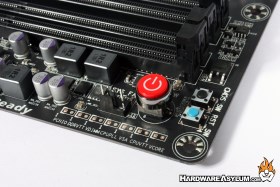Gigabyte Z77X-UD3H Motherboard Review
Author: Dennis Garcia
Published: Tuesday, July 03, 2012
Board Layout and Features
The new standard styling for Ultra Durable motherboards is to have a matte black PCB and let the accent colors show on the various heatsinks. Normally the accent color for the UD3 is grey however on the Z77 we can see the heatsink design has been changed along with the color, which are now an electric blue.
Expansion slots still follow the black color scheme and are unchanged from previous designs.
Expansion slots still follow the black color scheme and are unchanged from previous designs.
Flipping a motherboard over can tell you a lot about its construction. Here we can see that the back of the motherboard is virtually devoid of any surface components and features only minimal circuitry.
Moving to the CPU we can see the dark chrome CPU socket hardware positioned next to a rather small array of PWM components. One of the first things to be downsized on a mainstream motherboard is the size of the power delivery system and the Z77X-UD3H features what appears to be a four phase PWM using full driver MOSFET circuits for great power efficiency.
Moving to the CPU we can see the dark chrome CPU socket hardware positioned next to a rather small array of PWM components. One of the first things to be downsized on a mainstream motherboard is the size of the power delivery system and the Z77X-UD3H features what appears to be a four phase PWM using full driver MOSFET circuits for great power efficiency.
Dual channel memory comes standard on the Sandy Bridge and the Z77X-UD3H supports DDR3 modules up to 1600Mhz with a maximum of 32GB usable. Higher speed modules are likely supported including the popular 2133Mhz and various SOC modules. 24pin ATX power is located in the traditional location near the upper edge of the motherboard and out of the primary airflow.
A great new feature found on the Z77X is the inclusion of some benchtop controls including power, reset and CMOS clear. These come in handy when the motherboard is used outside of a chassis. Another great feature is the ability to check the various system voltages in real time, and you can do that using the test pads located under the power button.
A great new feature found on the Z77X is the inclusion of some benchtop controls including power, reset and CMOS clear. These come in handy when the motherboard is used outside of a chassis. Another great feature is the ability to check the various system voltages in real time, and you can do that using the test pads located under the power button.
Behind the PWM cooler you'll find the 8 pin CPU power connector with plenty of access space around the plug.







